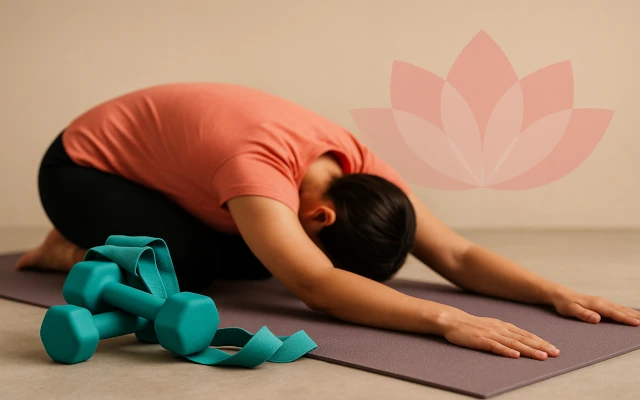By News Karnataka Editorial Team
Copyright newskarnataka

Millions of women worldwide suffer with weight control, hormone balance, and general well-being due to polycystic ovarian syndrome, or PCOS. Exercise is a strong complementary treatment that may greatly improve symptoms and quality of life for women with PCOS, even when pharmacological therapies like PCOS Homeopathy Treatment give vital aid.
Breaking the PCOS-Exercise Connection: Science Speaks Volumes
Exercise has a transformational impact on reducing PCOS, according to study. According to the most current policy statement from Exercise and Sports Science Australia, people with PCOS should aim to engage in 150–300 minutes of moderate-intensity aerobic exercise or 75–150 minutes of vigorous-intensity cardiovascular activity each week.
Exercise lessons ranging anywhere from 30 minutes a day, three times a week, to three hours per week have been found in studies to improve PCOS-related metabolic and reproductive symptoms. This evidence-based method shows that regular exercise quickly cures inflammation, insulin resistance, and hormone imbalances—the major conditions that drive PCOS symptoms.
The Power Trio: Resistance, Cardio, and Mind-Body Fusion
A well-rounded exercise program that includes aerobic, mind-body, and strength training is most useful for people with PCOS. This all-encompassing method concurrently tackles numerous components of PCOS therapy.
Resistance Training Revolution: Exercises involving bodyweight, resistance bands, and wrestling build lean muscle mass, which in turn improves insulin sensitivity. Strength training lessons two to three times a week are usually proven to greatly lower symptoms and improve metabolism in women seeking PCOS treatment in Mumbai.
Cardiovascular Champions: Because it improves insulin sensitivity, modest exercise, like brisk walking, can be highly useful for people with PCOS. Fun replacements like swimming, riding, and dancing make training interesting and long-lasting.
Yoga and Pilates: The Stress-Busting Superheroes
Stress reduction, better flexibility, and hormone balance are all assisted by adding flexibility activities like yoga and pilates in your PCOS exercise routine. Because they directly target cortisol levels and nervous system regulation, these mind-body methods offer unique benefits for PCOS control.
PCOS symptoms may be directly affected by yoga and pilates’ ability to lower cortisol and control the neurological system. Deep breathing techniques along with basic Pilates postures including downward dog, child’s pose, and core-focused routines give for excellent symptom management methods.
Creating Your Personal PCOS Exercise Blueprint
PCOS metabolism and reproductive complaints can be eased by engaging in three times a week, 30 minutes of exercise each day, for a total of three hours of exercise each week. Because of this method’s flexibility, women may change regimens to fit their likes and lives.
Weekly Structure Suggestions:
Monday: 30-minute strength training session
Wednesday: 45-minute moderate-intensity cardio
Friday: 30-minute yoga or Pilates class
Weekend: Recreational activities like hiking or dancing
This well-rounded method gives full PCOS symptom treatment while retaining the sustainability and enjoyment of exercise.
Integrating Exercise with Holistic PCOS Treatment
Prominent PCOS treatment centers in Mumbai recognize the value of exercise in all-encompassing care. Lifestyle changes, including as eating a balanced diet, exercising often, and having a healthy weight, are among the most helpful treatment.
A crucial component of PCOD treatment is lifestyle changes, with a special focus on nutrition and exercise. Exercise has a synergistic effect with PCOS homeopathic treatment that helps both physical symptoms and mental health.
Starting Your PCOS Exercise Journey: Practical Steps
Exercise gently for at least half an hour every day to reduce weight and boost insulin sensitivity. Setting small, manageable goals in the beginning helps you avoid overwhelm and create long-lasting habits.
Week 1-2: Start with 15-minute walks daily
Week 3-4: Add two 20-minute strength training sessions
Week 5-6: Incorporate yoga or stretching routines
Week 7+: Build toward the recommended 150-300 minutes weekly
The Long-Term Victory: Sustained Results Through Consistency
For women with PCOS to have beneficial health outcomes, they must participate in intensive exercise for at least 120 minutes per week; longer-term studies are necessary to measure long-term impacts. This study shows the benefits of consistency over intensity.
Women who mix PCOS homeopathic treatment with regular exercise generally report feeling happier, controlling their weight better, having more energy, and having more regular periods. The idea is to locate delightful pastimes that grow into lasting habits as opposed to band-aid treatments.
Exercise is a strong, easily available therapy for controlling PCOS that supports pharmacological treatments. Women may actively control their symptoms and achieve stronger, better bodies and minds by following evidence-based exercise plans.



